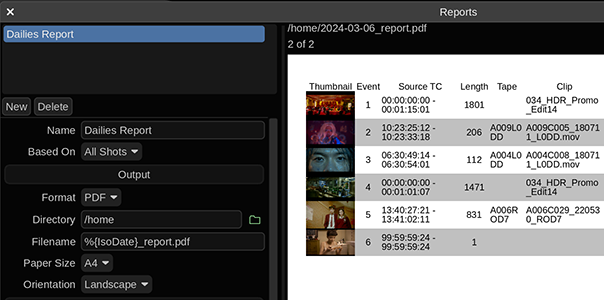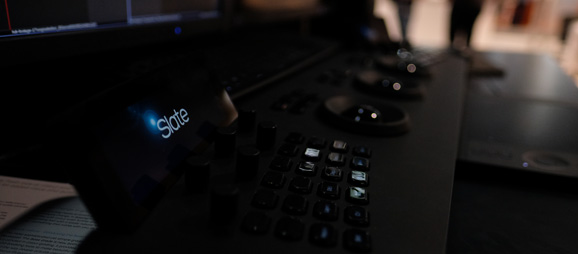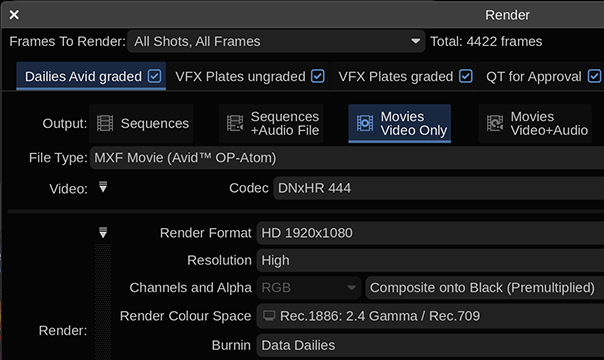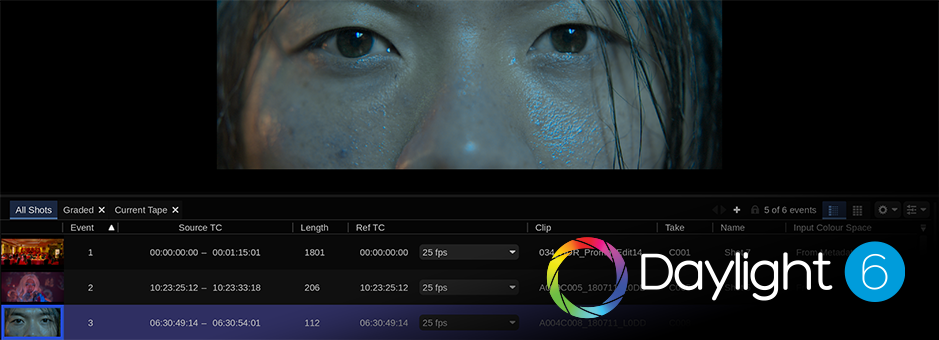Daylight 6.0 now available
A powerful dailies platform for shot management and high-performance transcoding
Daylight is designed as a compact yet powerful grading decision tool to help DoPs and directors establish looks and visualise what they have shot, on set or on location, as well as meeting all of the sophisticated deliverables requirements – in one application.
Daylight 6.0 is now available, enabling full interoperability with Baselight 6.0.
See the latest Daylight datasheet for more information, or contact your local Sales Representative or [email protected].

14-Day Trial gives you access to a fully functioning version of Daylight for 14 days.
3-Month Subscription allows you to access a full licence for Daylight for three (3) months.
Annual Subscription allows you to access a full licence for Daylight for one (1) year.
Support
If you need to download the Daylight installer again, or you are looking for the latest version, you can find it on the Daylight Support page.
If you have a specific question, email it to [email protected].
Full Baselight creativity
Grades can of course be limited to CDL values or exported as 3D LUTs for standard cross-platform workflows, but you don’t need to be constrained by the lowest common denominator. All shots can have full sophisticated Baselight looks – authored and applied using the same compact grading interface familiar to users of Baselight Editions for Avid and NUKE.
And now, with the release of Daylight 6.0 pre-authored looks can be quickly and easily applied from Chromogen, or targeted looks can be created using X Grade along with a range of other powerful operators and instantly applied to multiple shots. As Daylight contains the full creative toolset found in Baselight, it is also possible to build more advanced effects too – see the Baselight 6.0 Datasheet for more details.
Deploy with ease
Daylight is available for purchase or quarterly rental, and the freelance licence option allows the licence to be moved from machine to machine using a simple, web-based authentication scheme.
The Mac software will run on any system equipped with macOS 12-14. Using the same philosophy as Baselight Editions, Daylight uses whatever graphics card is installed without the need for special, CUDA-capable variants.
As your throughput requirements increase you can upgrade to the Linux version of Daylight (which runs on customer-supplied hardware and supports multiple Nvidia GPUs).
Extensive metadata support
Daylight provides comprehensive end-to-end handling of metadata. The system reads all the data it can from the headers of your camera and audio files and displays relevant metadata fields in FLUX Manage and the Shots View – and you can also choose to display information on thumbnails in the Scene and Galleries.
The Gallery has also adopted the Shots View metadata handling. These metadata fields can be combined into complex queries that can be saved as filters, or you can perform a quick text search on-the-fly.


Custom reporting
Daylight’s extensive metadata handling carries right on over into a sophisticated report generator that includes custom columns, colour accurate thumbnail images and cover pages. This means that you can produce a consistent, professional report at the end of every workday.
Transcoding in post
Daylight makes use of over 10 years of accumulated Baselight development to provide comprehensive support for all camera and deliverable formats – including audio and retiming capability.
Support for sophisticated rescaling, filtering, masking and burn-in operations, alongside Truelight Colour Spaces for accurate colour transforms, means that all of your deliverable requirements can be met by one application.
Comprehensive codec support
Baselight is well regarded for supporting all common RAW camera formats and delivery codecs natively as soon as they are released. This is carried across to Daylight, along with user-defined formats and a sophisticated format mapping system that allows resolution, aspect ratio, frame rate and colour space to be freely mixed within a project.
Audio sync & playback
Audio can easily be synced with your camera footage – either automatically using timecode, or semi-automatically using a clap-detector, which pinpoints the exact time in the audio file that the clapper closes.
Sound files that span multiple camera takes are easily handled and waveforms help you to manually adjust sound sync on a per-shot basis.

The fastest renderer never runs
Working with Baselight or Baselight Editions in post?
Of course, the sophistication of the Daylight render queue is welcome when you have to deliver graded files; however, the fastest renderer is the one that never runs. Instead of images, it delivers grading metadata.
If you are working with a post-production facility equipped with Baselight or Baselight Editions, the full grade from Daylight can be encapsulated in a completely portable, cross-platform BLG file. No amount of additional GPUs or CPUs can be as fast or as flexible as this workflow.
Heard about the BLG file (Baselight Grade file)?
It’s a multi-track OpenEXR file format that you can use to create, transfer and review looks.
When we use the term ‘look’, we’re not just talking about a LUT or a restricted grade – the look within the BLG is the full creative intent. It includes all grade information: colour space transforms, Truelight cubes, conform metadata and keyframes.
It interoperates fully with Baselight, Daylight and even Baselight Editions within Avid, NUKE and Flame, but you can use it as a review format without any FilmLight hardware or software.
Professional panel support
Daylight supports for Tangent Wave and Element panels, as well as Avid Artist Color and Transport devices. However, just because you’re grading dailies and don’t have the space, it doesn’t mean you can’t have a purpose-designed control surface. Our Slate panel is an ideal size for the near-set environment.
The Chalk application for Slate also lets you customise the buttons on the control surface to realise the high productivity required in an effective dailies process.


Render Queue with multiple deliverables
No need to wait for Daylight to finish rendering before you can start the next operation. You can easily pause, re-order and resubmit tasks to the Render Queue enabling you to work more efficiently.
You can even optimise the process by producing several deliverables simultaneously from the one scene; for example, producing QuickTime movies at the same time as rendered DPX files.




